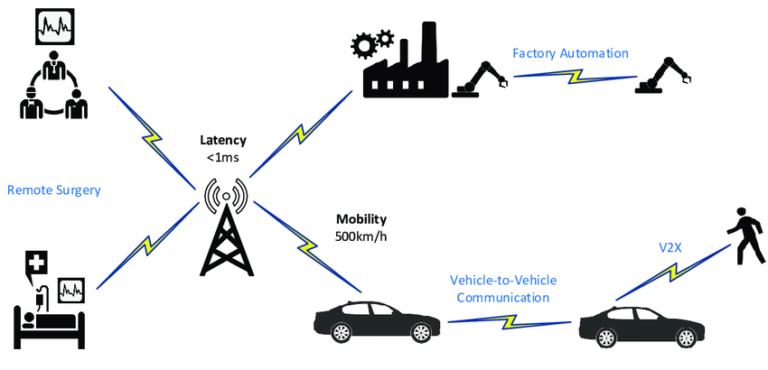5G is not just limited to mobile phones: IoT devices, medical equipment, and industrial equipment can connect to the network using technologies such as TDD, network slicing, and beamforming.
5G New Radio (NR) made its long-awaited commercial debut in late 2018. 5G NR (Figure 1) meets the enhanced Mobile Broadband (eMBB) requirements for smartphones, tablets and high-speed wireless hotspots. At the same time, four additional 5G standards that extend the core capabilities of 5G NR are optimized to efficiently support specific device, application and industry requirements.
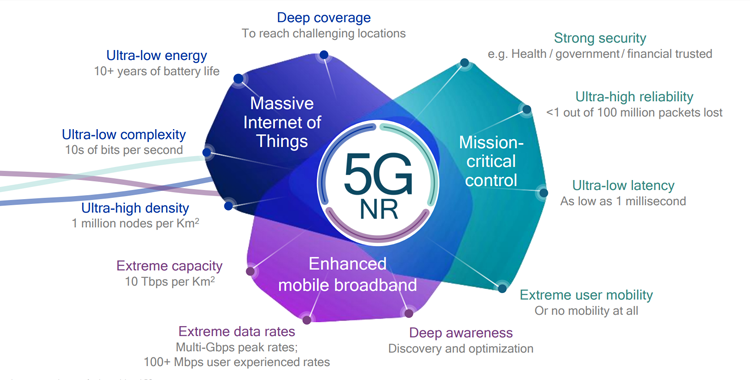
Figure 1. A graphical representation of 5G NR, highlighting key performance features. (Image: ResearchGate)
This article describes the five main types of 5G, focusing on technical specifications and use cases for NR, millimeter wave (mmWave), sub-6 GHz, ultra-reliable low latency communications (URLLC), and reduced capability (RedCap). It also introduces expected 5G advanced features, such as more effective network slicing techniques and enhanced multiple-input multiple-output (MIMO) configurations.
Exploring 5G NR Foundational Technologies
5G NR, which operates across a wide range of frequency bands from 410 MHz to 71 GHz, is the underlying technology for all 5G standards. Key features and capabilities include:
- Orthogonal Frequency Division Multiplexing (OFDM) increases spectral efficiency by splitting a radio signal into multiple smaller sub-signals, minimizing interference and improving large amounts of data management.
- Massive MIMO and Beamforming use many small antenna elements to enhance network capacity and data throughput. Complementing Massive MIMO, Beamforming precisely focuses and directs signals to further improve reception and mitigate interference.
- 256-QAM (Quadrature Amplitude Modulation) increases throughput by increasing the number of bits transmitted per symbol in the same spectrum.
- Carrier aggregation combines multiple frequency blocks to allow non-contiguous spectrum bands to be used simultaneously, effectively expanding bandwidth capabilities and supporting higher data rates.
- Subcarrier spacing optimizes frequency usage based on dynamic network conditions, improving network performance and flexibility.
- Dual connectivity allows your device to connect to multiple 5G bands simultaneously, expanding coverage and ensuring uninterrupted connections.
- Network slicing creates multiple virtual networks within a single physical 5G network, enabling optimized connectivity solutions with customized performance, security, and latency parameters.
- Advanced positioning, timing and synchronization provide critical positioning and synchronization capabilities for advanced driver assistance systems (ADAS), industrial automation, smart grid management and location tracking.
5G NR will support a wide variety of eMBB use cases, devices and verticals, some of which could greatly benefit from customized 5G standards that address their specific requirements and performance parameters.
5G mmWave: Bringing ultra-fast speeds to dense cities
For example, 5G mmWave operates at higher frequencies, typically in the 24GHz to 40GHz range, enabling multi-gigabit speeds (Figure 2), massive bandwidth, and ultra-fast data rates in dense urban areas. To overcome range limitations and ensure widespread coverage, mmWave relies on small cells, massive MIMO, beamforming, and adaptive beam tracking.
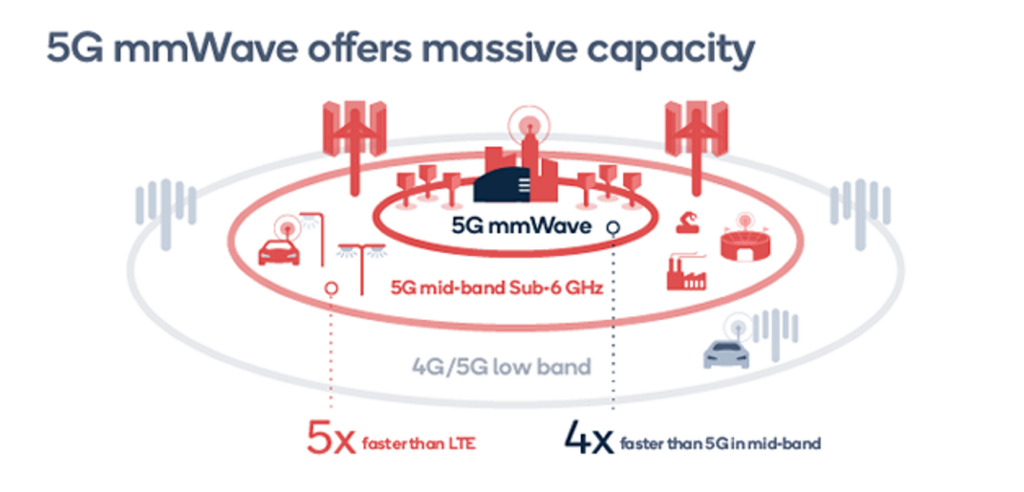
Figure 2. A detailed view showing mmWave speeds at mid-band frequencies are four times faster than 5G. (Image: Netgear)
Small cells expand mmWave coverage by shortening the distance signals have to travel and filling coverage gaps, while beamforming and adaptive beam tracking dynamically adjust the signal direction and strength to maintain a stable connection. Additionally, OFDM manages high bandwidth requirements by efficiently handling multiple signal channels, and 256-QAM increases data rates by encoding more bits into each signal element. Finally, subcarrier spacing and dual connectivity efficiently pair and seamlessly switch between mmWave and lower frequency bands.
5G mmWave is particularly effective for high data throughput applications such as 4K or 8K video streaming, virtual reality (VR), augmented reality (AR), and gaming. In cities, stadiums, and transportation hubs, it will support enterprise applications and smart city infrastructure such as Internet of Things (IoT) devices and real-time data analytics. 5G mmWave will also play a key role in facilitating fixed wireless access (FWA) in underserved and hard-to-wire areas.
Balancing Coverage and Capacity with 5G Sub-6GHz
5G sub-6GHz signals operate in frequency bands below 6GHz (Figure 3) balances the wide coverage of traditional cellular bands with the high capacity of mmWave frequencies. This spectrum range improves propagation, helping signals reach farther and penetrate buildings more effectively than mmWave frequencies. Sub-6 GHz has lower peak speeds and bandwidth compared to mmWave, but makes up for it with greater coverage and range.
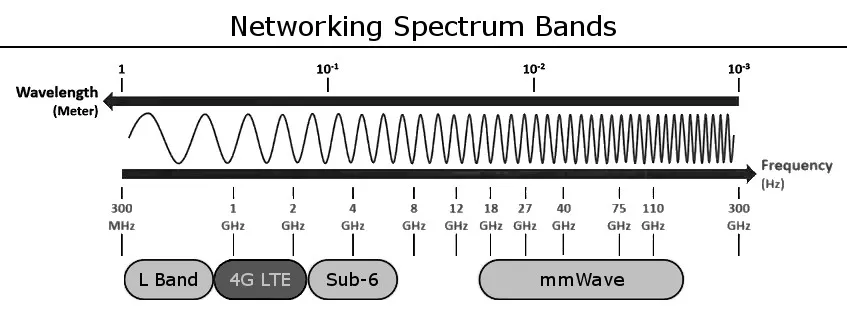
Figure 3. 5G network spectrum band diagram showing frequency vs. wavelength. 5G sub-6 GHz offers the best combination of coverage and capacity. (Image: Android Authority)
Sub-6 GHz uses Massive MIMO and advanced beamforming to increase signal strength and data rates, carrier aggregation combines non-contiguous frequency bands to increase bandwidth and data throughput, and uses OFDM to optimize spectral efficiency and streamline data transmission, employing 256-QAM to transmit more bits per symbol.
Essential to enabling 5G’s widespread coverage, sub-6 GHz ensures robust connectivity across a variety of environments and terrains, from suburban and rural areas to dense urban areas. Combining wide-area coverage with medium to high data speeds, sub-6 GHz serves a wide range of applications, including IoT, rural broadband, smart city infrastructure and agricultural technology. By supporting dual connectivity, sub-6 GHz also enables devices to simultaneously maintain connections with other frequencies, further enhancing reliability and data speeds.
5G RedCap: Bridging the Gap Between 5G NR and Previous Standards
Standardized in 3GPP (3rd Generation Partnership Project) Release 17, 5G RedCap supports key 5G NR features such as network slicing, precise positioning, precise timing, and synchronization. It effectively bridges the gap between 5G NR and traditional LTE-M and NB-IoT standards.Figure 4), 5G RedCap simplifies device design, dramatically reducing cost, antenna count and power consumption.
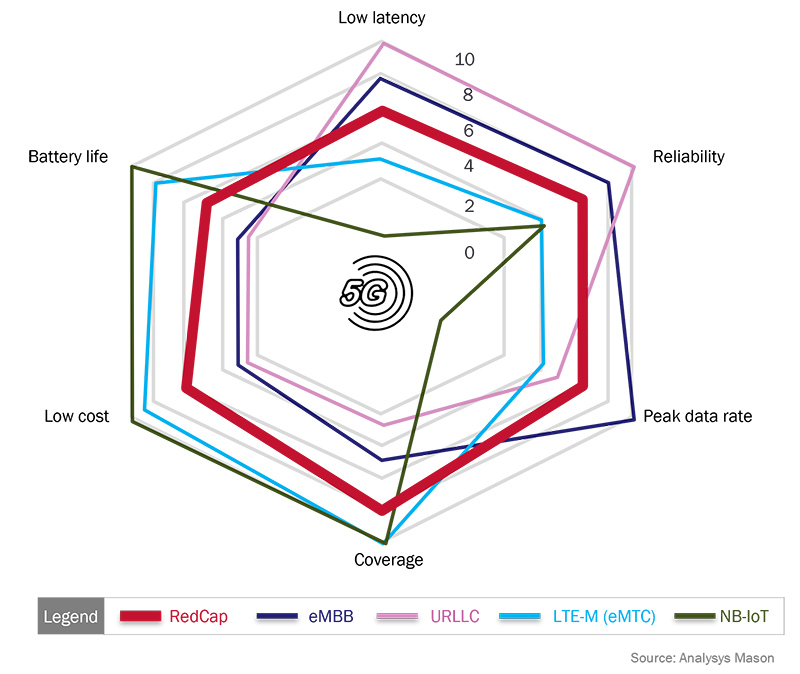
Figure 4. Radar chart comparing RedCap, eMBB, URLLC, LTE-M, and NB-IoT across various performance metrics including latency, reliability, battery life, cost, and coverage. (Image: Analysis Mason)
5G RedCap targets wearables, smart home devices, and consumer electronics devices with medium to high downlink speeds ranging from 100 Mb/s (uplink) to 220 Mb/s (downlink). In enterprise deployments, 5G RedCap will support smart office devices, remote surveillance systems, and warehouse or logistics management applications. Other use cases include AI-powered video surveillance, asset (location) tracking, and Industrial IoT (IIoT).
By deploying 5G RedCap alongside other 5G technologies such as mmWave and Sub-6 GHz, operators can effectively utilize network resources and meet specific service demands without significant changes. In particular, 5G RedCap is a cost-effective alternative to 5G URLLC, which primarily supports devices and applications that require the lowest possible latency.
5G URLLC delivers sub-millisecond latency
5G URLLC (Figure 5) uses advanced network techniques such as Time Division Duplex (TDD) to achieve sub-millisecond latency and efficiently use the same frequency band at different times on both the uplink and downlink. Additional techniques such as preemptive scheduling and prioritized resource allocation ensure seamless data transmission and 99.999% reliability. Performance is further enhanced by short transmission time intervals (TTIs), advanced modulation schemes, and robust error correction protocols.
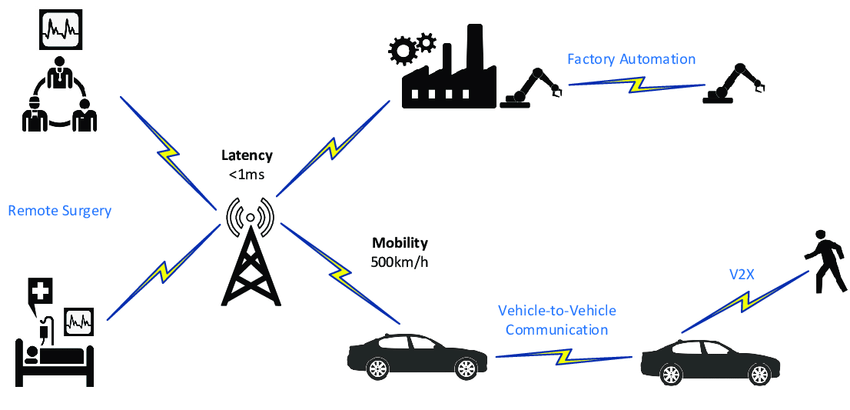
Figure 5. Detailed diagram showing 5G URLLC use cases. (Image: ResearchGate)
5G URLLC will enable the rapid transfer of data between AI-powered edge sensors in a range of automotive systems, including adaptive cruise control, lane departure warning, emergency braking systems and vehicle-to-vehicle communications. Similarly, 5G URLLC will support critical medical applications such as remote surgery that rely on real-time transmission of high-resolution video, precise control signals and advanced positioning capabilities. In industrial environments, URLLC will synchronize complex system functions, from energy grids and automated factories to smart agricultural systems.
5G-Advanced: Evolving Core NR Technology
5G-Advanced, outlined in 3GPP Release 18, complements core NR technology with 10Gbps speeds, more effective network slicing techniques, and enhanced Massive MIMO configurations for very large antenna arrays that will deliver Fixed Wireless Access (FWA) connections. 5G-Advanced also supports deterministic networks with time-dependent capabilities that ensure near-zero packet loss rates and bounded latency.
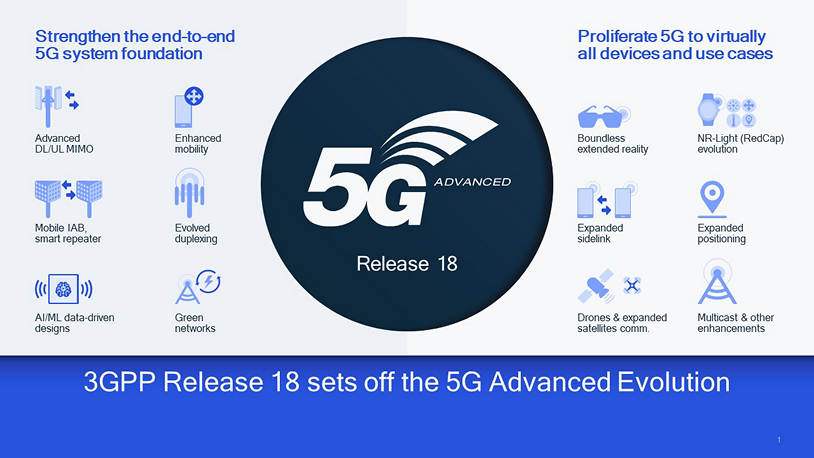 5G-Advanced extends mid-band frequencies from 7 GHz to 24 GHz, introduces new power-saving features for extended reality (XR) devices, facilitates signal timing with centimeter-level accuracy, and adds advanced artificial intelligence (AI) and machine learning (ML) capabilities to streamline network management and efficiency. 5G-Advanced targets many applications and devices, from edge computing and XR to automotive relays and satellite connectivity.
5G-Advanced extends mid-band frequencies from 7 GHz to 24 GHz, introduces new power-saving features for extended reality (XR) devices, facilitates signal timing with centimeter-level accuracy, and adds advanced artificial intelligence (AI) and machine learning (ML) capabilities to streamline network management and efficiency. 5G-Advanced targets many applications and devices, from edge computing and XR to automotive relays and satellite connectivity.
summary
5G NR is the foundational standard for 5G, offering extensive eMBB capabilities across a wide spectrum for a range of devices and applications. 5G mmWave delivers ultra-high speeds in dense urban environments through higher frequency bands, while 5G Sub-6 GHz ensures comprehensive coverage at moderate speeds in suburban and rural areas. 5G RedCap facilitates simplified device design and energy-efficient connectivity for IoT, enterprise, and consumer devices, while 5G URLLC provides ultra-reliable, low-latency communications for mission-critical applications. Finally, 5G-Advanced introduces faster speeds and advanced AI and ML capabilities along with improvements in MIMO.
References
5G System Overview, 3GPP
How RedCap Fits into 5G and IoT
What is 5G NR? Celona explains the new 5G wireless standard
Sub-6GHz and mmWave: A Different World of 5G Technology
Take an Inside Look at the 5G mmWave Signal Chain, 5G Technology World
URLLC: What it is and how it works, Antenova
5G-Advanced: Shaping the future of operator services, GSMA
How 5G RedCap helps accelerate and simplify 5G Private
Network Adoption, MosoLabs
What is 5G Advanced and when will it be released?, Android Authority
The Next Wave of 5G – 3GPP Release 19, Ericsson


